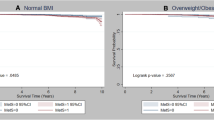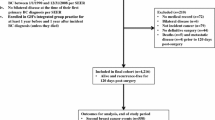Abstract
Purpose
Metabolic syndrome (MetS) and most of its components have been previously associated with increased breast cancer risk. We hypothesized that increasing number of MetS components would be positively associated with breast cancer risk.
Methods
Data were obtained from the Study of Osteoporotic Fractures, a prospective cohort of women aged ≥65 enrolled between 1986 and 1988 and still being followed prospectively (n = 8,956). MetS components evaluated at baseline were elevated waist circumference, hypertension, and diabetes. Data were not available on hyperlipidemia. Incident breast cancers were confirmed by pathology report. We compared women with 0, 1, and 2 or 3 MetS components. We used Cox proportional hazards regression to calculate associations for breast cancer overall and classified by prognostic features.
Results
At baseline, 28.8 % of participants had 2 or 3 MetS components. Over an average follow-up of 14.4 years, 551 breast cancer cases were identified. Compared to those with no components, women with 2 or 3 components had increased breast cancer risk (hazard ratio (HR), 1.30; 95 % confidence interval (CI), 1.01–1.68) and increased risk of ER+ (HR, 1.48; 95 % CI, 1.09–2.03) and PR+ (HR, 1.56; 95 % CI, 1.10–2.20) cancer, adjusting for age, hormone use, and family history of breast cancer. These results became attenuated and not statistically significant when additionally adjusted for body mass index.
Conclusions
MetS is associated with increased postmenopausal breast cancer risk, especially for ER+ and PR+ cancers, though this effect may not be independent of the effect of body mass index. Managing the components of MetS could be efficacious for breast cancer risk reduction.
Similar content being viewed by others
References
American Cancer S (2009) Cancer facts & figures 2009. American Cancer Society, Atlanta
Alberti KG, Eckel RH, Grundy SM, Zimmet PZ, Cleeman JI, Donato KA, Fruchart JC, James WP, Loria CM, Smith SC Jr., International Diabetes Federation Task Force on E, Prevention, Hational Heart L, Blood I, American Heart A, World Heart F, International Atherosclerosis S, International Association for the Study of O (2009) Harmonizing the metabolic syndrome: a joint interim statement of the International Diabetes Federation Task Force on Epidemiology and Prevention; National Heart, Lung, and Blood Institute; American Heart Association; World Heart Federation; International Atherosclerosis Society; and International Association for the Study of Obesity. Circulation 120(16):1640–1645
Wannamethee SG (2008) The metabolic syndrome and cardiovascular risk in the British Regional Heart Study. Int J Obes (2005) 32(Suppl 2) (Journal Article):S25-29
Hillier TA, Rizzo JH, Pedula KL, Cauley JA, Schwartz AV, Ensrud KE, Browner WS (2005) Increased mortality associated with the metabolic syndrome in older women with diabetes. Diabetes Care 28(9):2258–2260
Agnoli C, Berrino F, Abagnato CA, Muti P, Panico S, Crosignani P, Krogh V (2010) Metabolic syndrome and postmenopausal breast cancer in the ORDET cohort: a nested case-control study. Nutr Metab Cardiovasc Dis 20(1):41–48. doi:10.1016/j.numecd.2009.02.006
Kabat GC, Kim M, Chlebowski RT, Khandekar J, Ko MG, McTiernan A, Neuhouser ML, Parker DR, Shikany JM, Stefanick ML, Thomson CA, Rohan TE (2009) A longitudinal study of the metabolic syndrome and risk of postmenopausal breast cancer. Cancer Epidemiol Biomarkers Prev 18(7):2046–2053. doi:10.1158/1055-9965.EPI-09-0235
Rosato V, Bosetti C, Talamini R, Levi F, Montella M, Giacosa A, Negri E, La Vecchia C (2011) Metabolic syndrome and the risk of breast cancer in postmenopausal women. Ann Oncol. doi:10.1093/annonc/mdr025
Capasso I, Esposito E, Pentimalli F, Crispo A, Montella M, Grimaldi M, De Marco M, Cavalcanti E, D’Aiuto M, Fucito A, Frasci G, Maurea N, Esposito G, Pedicini T, Vecchione A, D’Aiuto G, Giordano A (2011) Metabolic syndrome affects breast cancer risk in postmenopausal women: National Cancer Institute of Naples experience. Cancer Biol Ther 10(12):1240–1243
Bjorge T, Lukanova A, Jonsson H, Tretli S, Ulmer H, Manjer J, Stocks T, Selmer R, Nagel G, Almquist M, Concin H, Hallmans G, Haggstrom C, Stattin P, Engeland A (2010) Metabolic syndrome and breast cancer in the me-can (metabolic syndrome and cancer) project. Cancer Epidemiol Biomarkers Prev 19(7):1737–1745. doi:10.1158/1055-9965.epi-10-0230
Healy LA, Ryan AM, Carroll P, Ennis D, Crowley V, Boyle T, Kennedy MJ, Connolly E, Reynolds JV (2010) Metabolic syndrome, central obesity and insulin resistance are associated with adverse pathological features in postmenopausal breast cancer. Clin Oncol (R Coll Radiol) 22(4):281–288. doi:10.1016/j.clon.2010.02.001
Maiti B, Kundranda MN, Spiro TP, Daw HA (2010) The association of metabolic syndrome with triple-negative breast cancer. Breast Cancer Res Treat 121(2):479–483. doi:10.1007/s10549-009-0591-y
Pasanisi P, Berrino F, De Petris M, Venturelli E, Mastroianni A, Panico S (2006) Metabolic syndrome as a prognostic factor for breast cancer recurrences. Int J Cancer 119(1):236–238. doi:10.1002/ijc.21812
Cauley JA, Lucas FL, Kuller LH, Vogt MT, Browner WS, Cummings SR (1996) Bone mineral density and risk of breast cancer in older women: the study of osteoporotic fractures. Study of osteoporotic fractures research group [see comment]. JAMA 276(17):1404–1408
Cummings SR, Nevitt MC, Browner WS, Stone K, Fox KM, Ensrud KE, Cauley J, Black D, Vogt TM (1995) Risk factors for hip fracture in white women. Study of osteoporotic fractures research group. N Engl J Med 332(12):767–773
Fredman L, Doros G, Cauley JA, Hillier TA, Hochberg MC (2010) Caregiving, metabolic syndrome indicators, and 1-year decline in walking speed: results of caregiver-SOF. J Gerontol Ser A Biol Sci Med Sci 65(5):565–572
Stone K, Bauer DC, Black DM, Sklarin P, Ensrud KE, Cummings SR (1998) Hormonal predictors of bone loss in elderly women: a prospective study. The study of osteoporotic fractures research group. J Bone Miner Res 13(7):1167–1174. doi:10.1359/jbmr.1998.13.7.1167
Browner WS, Lui LY, Cummings SR (2001) Associations of serum osteoprotegerin levels with diabetes, stroke, bone density, fractures, and mortality in elderly women. J Clin Endocrinol Metab 86(2):631–637
Vogt MT, Cauley JA, Scott JC, Kuller LH, Browner WS (1996) Smoking and mortality among older women: the study of osteoporotic fractures. Arch Intern Med 156(6):630–636
Rubin DB (1976) Inference and missing data. Biometrika 63:581–592
Suzuki R, Orsini N, Saji S, Key TJ, Wolk A (2009) Body weight and incidence of breast cancer defined by estrogen and progesterone receptor status–a meta-analysis. Int J Cancer 124(3):698–712. doi:10.1002/ijc.23943
Vona-Davis L, Howard-McNatt M, Rose DP (2007) Adiposity, type 2 diabetes and the metabolic syndrome in breast cancer. Obes Rev 8(5):395–408. doi:10.1111/j.1467-789X.2007.00396.x
Largent JA, Bernstein L, Horn-Ross PL, Marshall SF, Neuhausen S, Reynolds P, Ursin G, Zell JA, Ziogas A, Anton-Culver H (2010) Hypertension, antihypertensive medication use, and breast cancer risk in the California teachers study cohort. Cancer Causes Control 21(10):1615–1624. doi:10.1007/s10552-010-9590-x
Lindgren A, Pukkala E, Tuomilehto J, Nissinen A (2007) Incidence of breast cancer among postmenopausal, hypertensive women. Int J Cancer 121(3):641–644. doi:10.1002/ijc.22689
Soler M, Chatenoud L, Negri E, Parazzini F, Franceschi S, la Vecchia C (1999) Hypertension and hormone-related neoplasms in women. Hypertension 34(2):320–325
Acknowledgments
The SOF is supported by National Institutes of Health funding. The National Institute on Aging (NIA) provides support under the following grant numbers: R01 AG005407, R01 AR35582, R01 AR35583, R01 AR35584, R01 AG005394, R01 AG027574, and R01 AG027576.
Author information
Authors and Affiliations
Corresponding author
Rights and permissions
About this article
Cite this article
Reeves, K.W., McLaughlin, V., Fredman, L. et al. Components of metabolic syndrome and risk of breast cancer by prognostic features in the study of osteoporotic fractures cohort. Cancer Causes Control 23, 1241–1251 (2012). https://doi.org/10.1007/s10552-012-0002-2
Received:
Accepted:
Published:
Issue Date:
DOI: https://doi.org/10.1007/s10552-012-0002-2




